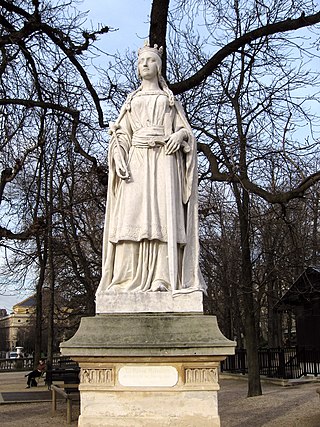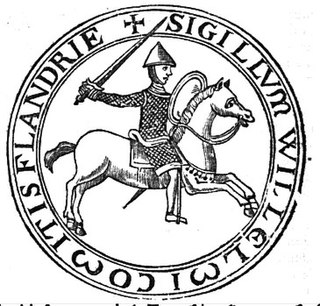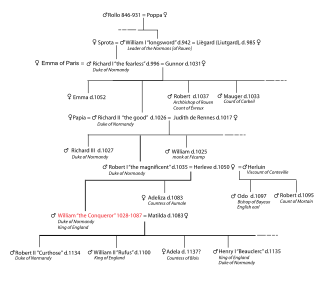Related Research Articles

William I, usually known as William the Conqueror and sometimes William the Bastard, was the first Norman king of England, reigning from 1066 until his death in 1087. A descendant of Rollo, he was Duke of Normandy from 1035 onward. By 1060, following a long struggle to establish his throne, his hold on Normandy was secure. In 1066, following the death of Edward the Confessor, William invaded England, leading an army of Normans to victory over the Anglo-Saxon forces of Harold Godwinson at the Battle of Hastings, and suppressed subsequent English revolts in what has become known as the Norman Conquest. The rest of his life was marked by struggles to consolidate his hold over England and his continental lands, and by difficulties with his eldest son, Robert Curthose.

Matilda of Flanders was Queen of England and Duchess of Normandy by marriage to William the Conqueror, and regent of Normandy during his absences from the duchy. She was the mother of ten children who survived to adulthood, including two kings, William II and Henry I.
William of Poitiers was a Frankish priest of Norman origin and chaplain of Duke William of Normandy, for whom he chronicled the Norman Conquest of England in his Gesta Willelmi ducis Normannorum et regis Anglorum or Gesta Guillelmi II ducis Normannorum. He had trained as a soldier before taking holy orders.

Robert the Magnificent was the duke of Normandy from 1027 until his death in 1035.

William Clito was a member of the House of Normandy who ruled the County of Flanders from 1127 until his death and unsuccessfully claimed the Duchy of Normandy. As the son of Robert Curthose, the eldest son of William the Conqueror, William Clito was seen as a candidate to succeed his uncle King Henry I of England. Henry viewed him as a rival, however, and William allied himself with King Louis VI of France. Louis installed him as the new count of Flanders upon the assassination of Charles the Good, but the Flemings soon revolted and William died in the struggle against another claimant to Flanders, Thierry of Alsace.

The Duchy of Normandy grew out of the 911 Treaty of Saint-Clair-sur-Epte between King Charles III of West Francia and the Viking leader Rollo. The duchy was named for its inhabitants, the Normans.

In the Middle Ages, the duke of Normandy was the ruler of the Duchy of Normandy in north-western France. The duchy arose out of a grant of land to the Viking leader Rollo by the French king Charles the Simple in 911. In 924 and again in 933, Normandy was expanded by royal grant. Rollo's male-line descendants continued to rule it until 1135. In 1202 the French king Philip II declared Normandy a forfeited fief and by 1204 his army had conquered it. It remained a French royal province thereafter, still called the Duchy of Normandy, but only occasionally granted to a duke of the royal house as an apanage.

Richard II, called the Good, was the duke of Normandy from 996 until 1026.
William III, called Towhead from the colour of his hair, was the "Count of the Duchy of Aquitaine" from 959 and Duke of Aquitaine from 962 to his death. He was also the Count of Poitou from 935 and Count of Auvergne from 950. The primary sources for his reign are Ademar of Chabannes, Dudo of Saint-Quentin, and William of Jumièges.
Alan III of Rennes was Count of Rennes and duke of Brittany, by right of succession from 1008 to his death.

The Battle of Val-ès-Dunes was fought in 1047 by the combined forces of the Norman duke William II and the French king Henry I against the forces of several rebel Norman barons, led by William's cousin Guy of Brionne.
Robert de Beaumont, 1st Earl of Leicester, Count of Meulan, also known as Robert of Meulan, was a powerful Norman nobleman, one of the very few proven Companions of William the Conqueror during the Norman Conquest of England in 1066, and was revered as one of the wisest men of his age. Chroniclers spoke highly of his eloquence and his learning, and three kings of England valued his counsel. He was granted immense land-holdings in England by William the Conqueror and by Henry I and was created Earl of Leicester.
Gilbertde Brionne, Count of Eu and of Brionne, was an influential nobleman in the Duchy of Normandy in Northern France. He was one of the early guardians of Duke William II in his minority, and a first cousin to William's father Duke Robert. Had Lord Brionne not been murdered, the senior house of de Clare would probably have been titled de Brionne. Lord Brionne was the first to be known by the cognomen Crispin because of his hair style which stood up like the branches of a pine tree.
Enguerrand II was the son of Hugh II count of Ponthieu. He assumed the county upon the death of his father on November 20, 1052.

William of Talou, Count of Talou (Arques) was a powerful member of the Norman ducal family who exerted his influence during the early reign of William the Conqueror Duke of Normandy.
Reginald I was the second count of the Free County of Burgundy. Born in 986, he was the son of Otto-William, the first count, and Ermentrude de Roucy.

The Battle of Mortemer was a defeat for Henry I of France when he led an army against his vassal, William the Bastard, Duke of Normandy in 1054. William was eventually to become known as William the Conqueror after his successful invasion and conquest of England.
Osbern the Steward, known in French as Osbern de Crépon, was the Steward of two Dukes of Normandy and the father of William FitzOsbern, 1st Earl of Hereford, one of William the Conqueror's closest counsellors.

Bertha of Blois, was a Duchess consort of Brittany and a countess consort of Maine.
Ralph de Gacé Seigneur de Gacé and other estates in Normandy, was a member of the House of Normandy who played a significant role during the minority of William the Conqueror.
References
- 1 2 3 Crouch 2006, p. 65.
- 1 2 3 Hagger 2017, p. 326.
- ↑ Douglas 1964, p. 38.
- 1 2 Potter 1999, p. 181.
- 1 2 Douglas 1964, p. 65.
- ↑ Douglas 1964, pp. 47–55.